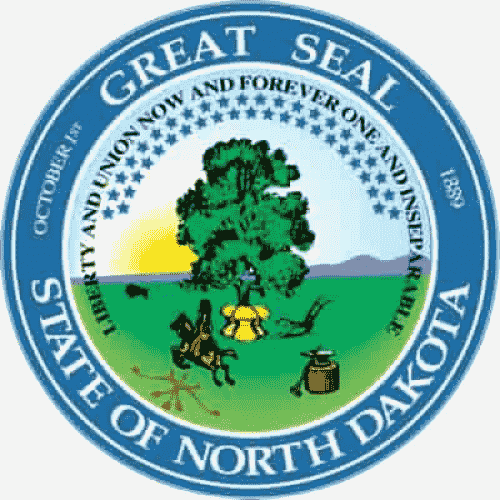 State Flag |  State Seal |
North Dakota is a state located in the Upper Midwestern region of the United States. It is bordered by Canada to the north, the states of Minnesota to the east, South Dakota to the south, and Montana to the west.
- ABBREVIATION: ND
- NICKNAME: The Rough Rider State
- POPULATION: 796,568 (2024 est.)
- CAPITAL: Bismarck
- STATE BIRD: Western Meadowlark
- STATE FLOWER: Wild Prairie Rose
- AREA: 70,700 sq. mi.
- TIME ZONE: Most of state: Central – southwest: Mountain
- ENTERED UNION: Nov. 2, 1889
- ALTITUDE: High, 3,508 ft. White Butte
- CLIMATE: Generally severe winters, short hot summers. Predominately semi-arid and subject to droughts; moderate rainfall in the southeast.
The central point of North America lies in North Dakota-Approximately 1,500 miles equidistant from the Atlantic, the Pacific, the Gulf of Mexico, and the Artic Archipelago. Here is a land of vivid colors and contrasting forms. The northern Red River Valley, once the bed of an ancient glacial lake, is one of the most fertile agricultural regions in the nation.
On the valley’s rich black soil rolls a yellow ocean of spring wheat, speckled here and there with blue fields of flax, from which linseed oil is extracted. In flax production North Dakota leads the nation, it comes in second for production of spring wheat.
On the state’s central drift plain, spotted with salt lakes, grain crops like barley, rye, and durum wheat flourish. In the west are the Dakota Badlands, so called because they often impeded early travelers with treacherously sandy soils and weirdly eroded sandstone buttes.
But now the Badlands have a symbolic value. They roof a part of the vast Williston Basin, an underground treasure house of petroleum and potash resources. As one prospector said in 1952, shortly after the riches were discovered, “it’s not just one oil field, it’s an oil province.”

Wild Prairie Rose, North Dakota
With its limited amount of rainfall, North Dakota has always had a water shortage. Although the rich land can be extremely productive, it is so sensitive to variations in annual rainfall that the wheat harvest can fluctuate wildly, however, agriculture is still the largest industry in North Dakota.
Fun Facts:
- Sunflowers grow as tall as 13 feet in North Dakota.
- Each year a demolition derby using farm combines is held at the State Fair in Minot.
- Devils Lake, the largest natural body of water in North Dakota, is known among fishermen as the Perch Capital of the World.
- More waterfowl hatch in the many prairie kettle hole and sloughs of North Dakota than in any other state.
- A bronze statue of Sakakawea and her baby son Jean Baptiste stands at the entrance to the North Dakota Heritage Center on the grounds of the state capitol in Bismark.
- Explorers William Clark and Meriwether Lewis and the Corps of Discovery spent more time in what is now North Dakota than any other place on their journey.
History:
North Dakota, located in the Upper Midwest of the United States, has a history that stretches back thousands of years. From its Indigenous roots to its development as an agricultural powerhouse, North Dakota’s story is one of adaptation, perseverance, and transformation.
Long before European explorers arrived, North Dakota was home to Native American tribes who thrived on the vast prairies and river valleys. Tribes such as the Mandan, Hidatsa, Arikara, Dakota (Sioux), and Chippewa built rich cultures based on hunting, farming, and trade.
The Mandan and Hidatsa, for example, lived in permanent earth-lodge villages along the Missouri River and grew crops like corn, beans, and squash. These tribes established extensive trade networks that stretched across the continent.
The first Europeans to explore the region were French fur traders in the 18th century. These traders established economic relationships with the Native tribes, exchanging goods for valuable pelts. In 1804, the Lewis and Clark Expedition traveled through what is now North Dakota, spending the winter at Fort Mandan near present-day Washburn.
Their journey introduced the region to more Americans and laid the groundwork for future settlement.
North Dakota became part of the United States through the Louisiana Purchase in 1803. For much of the 19th century, the region remained largely undeveloped, inhabited primarily by Native peoples and fur traders.
The U.S. government eventually established military forts to protect settlers and trade routes, but these also signaled increasing tensions with Native tribes. Conflict escalated during the mid-1800s, culminating in forced relocations and the eventual confinement of Native peoples to reservations.
The late 1800s brought dramatic change with the expansion of the railroad and the passage of the Homestead Act of 1862, which encouraged settlers to move west by offering free land. Immigrants from Germany, Norway, Sweden, and other parts of Europe flocked to North Dakota to start new lives.
They established farms across the fertile plains, making agriculture the backbone of the state’s economy.
On November 2, 1889, North Dakota became the 39th state admitted to the Union, alongside its neighbor South Dakota.
The state quickly became a leading producer of wheat and other grains. Its economy and society were shaped by a rural, agrarian lifestyle, but also by a strong tradition of populism and political activism, exemplified by the rise of the Nonpartisan League in the early 20th century.
During the Great Depression and Dust Bowl of the 1930s, North Dakota faced severe hardships as drought and falling crop prices devastated rural communities. Recovery came with federal New Deal programs and technological improvements in farming.
Today, North Dakota is known for both its agricultural output and its energy sector, particularly oil production in the Bakken Formation. While still largely rural, the state has grown in population and economic diversity.